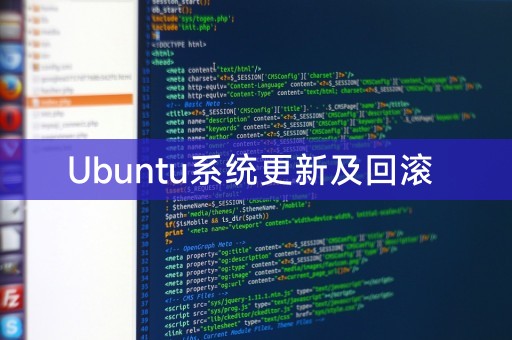
php editor Zimo introduces you to Ubuntu system update and rollback. The Ubuntu system is a widely used open source operating system. Regular updates are an important way to keep the system safe and functional. System updates can bring new features and fix known security vulnerabilities, but they can sometimes cause problems. Rollback refers to restoring the system to a previous version to solve problems that occurred after the update. This article will explain in detail the Ubuntu system update methods and techniques, and introduce the rollback steps and precautions to help you better manage and maintain your Ubuntu system.

Ubuntu system update refers to updating software packages and kernel to obtain the latest features and fix known problems. The following is the method of Ubuntu system update:
1. Use the command line to update: Open the terminal and enter the following command to update the system:
```
sudo apt update
sudo apt upgrade
The first command is used to update the list of available software packages, and the second command is used to install available updates. Depending on the system, you may need to enter the administrator password.
2. Use the Software Center to update: The Ubuntu system provides a graphical tool called "Software Updater", which can easily update the system. Open "Software Updater" and if there are available updates, it will be displayed. On the interface, click the "Install Now" button to update.
3. Automatic update settings: The Ubuntu system also provides automatic update options, which can be configured in the "Software & Updates" settings. Select the "Updates" tab to set when the system will automatically update. , and whether to automatically install security updates, etc.
Sometimes, system updates may cause some problems, such as incompatibility with certain software or performance degradation. At this time, we can roll back to the previous version to solve the problem. The following is the Ubuntu system Steps for update rollback:
1. Use Timeshift to take a system snapshot: Timeshift is a backup and system recovery tool that can help us create a system snapshot. Before the system is updated, we can use Timeshift to create a snapshot of the current system. Snapshot in case you need it.
2. Roll back to the previous version: If problems occur after the system is updated, you can use Timeshift to roll back to the previous version. Open Timeshift, select the previously created snapshot, and click the "Restore" button to roll back. , the rollback process may take some time, please be patient.
3. Verify the rollback results: After the rollback is completed, restart the system and verify whether the problem is resolved. If the problem still exists, you can try other methods to solve it, or contact the Ubuntu community for help.
When using the Ubuntu system, it is very important to update the system in time to obtain better performance and security. Sometimes system updates may cause some problems. In order to deal with these problems, we need to learn how to Rolling back to the previous version, using Timeshift for system snapshots and rollback operations can help us effectively solve the problem. Remember to back up the system and data regularly, just in case. I hope this article will be helpful to you when using the Ubuntu system.
The above is the detailed content of Ubuntu system update and rollback. For more information, please follow other related articles on the PHP Chinese website!




